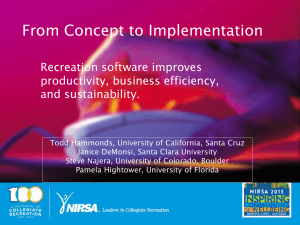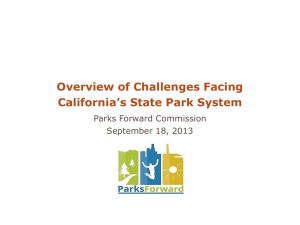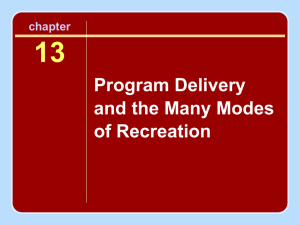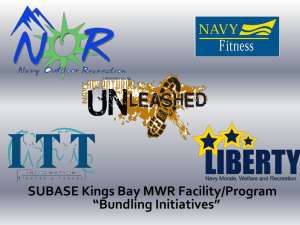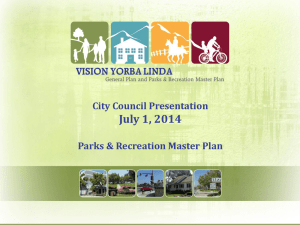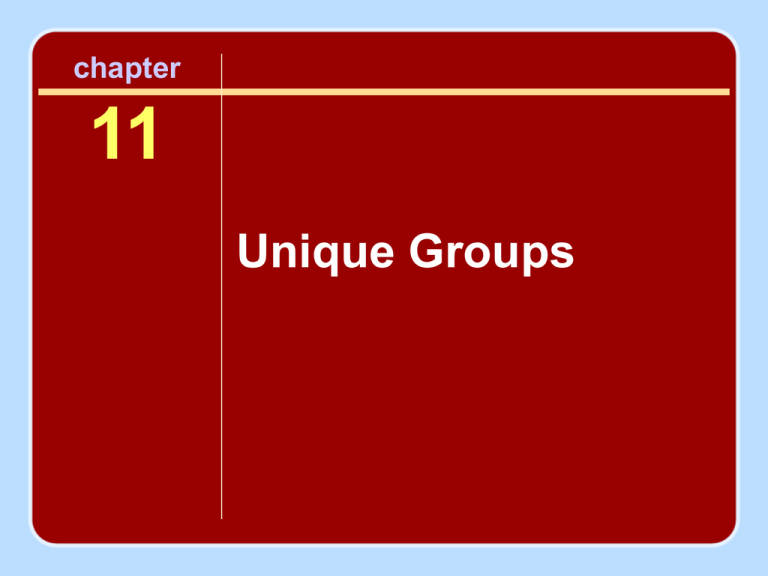
chapter
11
Unique Groups
Unique Recreation
• Campus recreation
Serves students and often faculty and staff at universities
and colleges.
• Recreation in correctional facilities
Can instill in offenders more appropriate outlets for
emotional expression.
• Faith-based recreation
Often includes a spiritual dimension and emotional
expression.
• Employee or corporate recreation and wellness
Serves employees within corporations.
• Armed forces recreation
Supports U.S. and Canadian military personnel and their
families at their home stations and in deployed environments
at remote sites around the world.
Campus Recreation:
Involvement by Colleges
• At the beginning of the 21st century, an
estimated 2,250 institutions ran intramural
programs that attracted 12 million
participants.
• $1.5 billion U.S. was recently spent to
renovate or build new state-of-the-art
collegiate recreational and sport facilities.
(NIRSA, 2004)
Comprehensive
Campus Recreation Program
Includes diversity of facilities and programs such
as the following:
•
•
•
•
•
•
Climbing walls and high-ropes challenge courses
Multipurpose activity courts
Specialized fitness areas
Special events such as tournaments, homecoming events
Intramural and club sports
Outdoor programs such as weekend camping, backpacking,
and canoe trips
• Outdoor pursuits rental centers, tennis courts, and golf
courses
• Classes, informal recreation, and social events
History of Campus Recreation
• Intramural sports began as student-initiated
and sponsored athletic contests in eastern
colleges.
• In 1913, first professional staff members
were hired to direct programs for men at the
University of Michigan and the Ohio State
University.
• After WWII, campus recreation expanded
because of significant growth in student
enrollment.
Birth of a National Organization
• National Intramural Association (NIA), 1950
Formed following a meeting of 20 African American male
and female intramural directors from 11 historically black
colleges. Conference organized by Dr. William Wasson,
at Dillard University in New Orleans.
• NIA evolved into National Intramural-Recreational
Sports Association (NIRSA)
In 2004, NIRSA represented primarily college and
university recreational sports programs, serving 7 million
college students.
Campus Recreation
in Today’s Colleges and Universities
• Campus recreation defined
Diverse facilities and programs to promote physical,
emotional, and social growth by encouraging the
development of lifelong skills and positive attitudes
through recreational activities.
• Purpose and justification: 7 goals
1.
2.
3.
4.
5.
6.
7.
Participate in a variety of activities
Provide value to participants
Enhance recruitment and retention initiatives
Coordinate the use of campus recreation facilities
Provide extracurricular education opportunities
Contribute positively to institutional relations
Cooperate with academic units
Benefits
“Students who participate in recreational
sports tend to develop positive self-images,
awareness of strengths, increased tolerance
and self-control, stronger social interaction
skills, and maturity—all gleaned from
recreational sports experiences” (NIRSA,
n.d., paragraph 1).
Summary
• Campus recreation, intramural, and
recreational sports programs will continue
to flourish and grow and will provide critical
avenues of expression as our society
becomes more and more technologically
oriented (Karabetsos,1991).
• This field has grown into a dynamic,
exciting area with diverse career
opportunities.
Correctional Recreation
• The inability to use free time in ways
considered to be socially acceptable can
lead to incarceration.
• A significant portion of the population does
not support correctional recreation, despite
the fact that these programs can expose
offenders to more socially acceptable
means of spending their free time.
Discussion:
Subject: Correctional Recreation
A significant portion of the population does
not support correctional recreation,
despite the fact that such programs can
expose offenders to more socially
acceptable means of spending their free
time.
•
•
What is your position?
Also, please comment on the pros and cons of
such programs
Role of Recreation
in Different Settings
• The nature of the facility determines the role of
recreation.
• People housed within the correctional system are
charged with a range of crimes.
– Represent all races, backgrounds, origins, physical
conditions, and age groups.
– Some have never been incarcerated, while others are
repeat offenders.
• These factors, along with the size of the facility and the
number of staff available, present one of the biggest
challenges to the provision of recreation programming.
Programming Considerations
• Number one concern is safety, both of
participants and staff.
• Each activity must be carefully examined to
identify potential hazards.
• Careful supervision is required, including
accounting for all equipment.
• Correctional institutions can be aggressive
and hostile settings; therefore, it’s
important not to agitate offenders.
Programming Goals
• Develop outlets for stress and enhance self-esteem.
• Identify activities that serve as alternatives to
addictions.
• Foster interpersonal skills, such as trust, cooperation,
and teamwork.
• Increase access to new social environments.
• Foster new interests.
• Negotiate constraints.
• Develop awareness of personal needs and appropriate
avenues to satisfy them.
• Develop decision-making and problem-solving skills.
• Develop new interests that could evolve into a career.
Correctional Recreation Professional
•
•
•
•
•
College degree: associate’s, bachelor’s, or master’s
Certification in first aid and CPR
Polygraph tests and background checks
Fluency in a second language (helpful)
Credentials such as certified personal trainer,
therapeutic recreation specialist, or certified leisure
professional (helpful)
Specific job titles vary from facility to facility; the role of
correctional recreation personnel is the same in both
the United States and Canada.
Trends and Issues
• Affected by societal trends both from the
client and administrative perspective.
• Challenging issues are as follows:
–
–
–
–
–
Incarceration rates
Budget cuts
Philosophical shifts
Aging infrastructure
Special needs of the incarcerated population based
on factors such as age, sex, and race
Introduction
to Faith-Based Recreation
• It is important to recognize and understand
the role religious institutions play in
providing satisfying recreational
opportunities within their communities.
• When considering how well we respond to
people of faith in a public setting, reflect on
this statement: How well do recreation
providers meet the needs of religiously
committed people?
First Amendment to the Constitution
• “Congress shall make no law respecting an
establishment of religion, or prohibiting the free
exercise thereof” (First Amendment to the U.S.
Constitution).
• Canadian government set a goal to increase
physical activity levels by 10% by 2010. Recreation
providers must understand barriers that limit
people of different faiths from participating in all
activities.
• Clothing preferences and rules of physical contact
of a variety of cultures, including the ever growing
populations of Muslims, Jews, and Sikhs in both
countries (to name a few).
Unique Differences
Within Faith Traditions
• Religious groups are not necessarily one
homogeneous unit:
– Have different ways of thinking about their beliefs
– Beliefs fostered by different ethnic roots
• Differences relate to individual
commitments and ethnic backgrounds:
– Some religious beliefs intentionally and fully shape
their recreation choices.
– Others express beliefs only unintentionally and
partially shape their recreation choices.
Unique Differences
Between Faith Traditions
• Nationality provides shape and encourages
some to recreate with people of similar
interests, background, religious affiliation,
and language. This is called selectiveacculturation in leisure (Shaull & Gramann,
1998).
• Different faith groups find roots in different
leaders.
Islam
• Nearly 20% of the world’s population follows the
teachings of Islam.
• Muslims make up the fastest growing religious group in
the United States (Kosmin, Mayer, & Keysar, 2001).
• Sports have been encouraged as a means to personal
well-being and, in part, to being well-prepared in case of
war (Anahar, Becker, & Messing, 1992).
• Recreation cannot take away from family
responsibilities of watching over siblings and doing
other household duties or school work (Carrington,
Chivers, & Williams, 1987; De Knop, Theeboom, Wittock,
& De Martelaer, 1996; Fleming, 1993).
Considerations in
Recreation Programming for Muslims
• Speak with Muslim clergy, parents, and participants
for advice about advancing recreation participation.
• Respect clothing and modesty issues.
• Respect prayer and Ramadan rituals.
• Provide segregated games for females and males.
• Make showers optional or provide private stalls for
showering and changing.
• Muslims should encourage the development of
Muslim-specific clubs and organizations (Kahan,
2003a).
Christianity
During the past 100 years, congregations
have enjoyed togetherness in church
buildings with activities such as the
following:
•
•
•
•
•
Coffee socials
Boys and girls clubs
Annual church picnics
Dances
Competitive leagues with teams from other similar
churches
Recreation Programming
for Christians
• KidsGames, modeled after the Olympics, began in
Barcelona in 1985 and has grown worldwide. Includes
summer camps at churches, Bible knowledge, poster
contest, and essay questions (Bynum, 2003).
• Adult church leagues generally do not permit alcohol
use at games, and they also have time built in for
prayer, fellowship, and witnessing.
• In small-town churches in Ontario, sport is ranked
lowest in current activities.
• Association of Church Sports and Recreation Ministers
(CSRM) helps churches use sport and recreation
programs to reach out to their communities.
Judaism
• Jews distinguish between sacred and
secular activities, thereby providing an
alternative perspective on faithful living in
one’s recreation.
• Reasons for engaging with Jewish
Community Centers or the Maccabiah
Games are less about faith and more about
the survival of their nation.
Recreation Programs for Jews
• Recreation programs are completely
secular. The recreation centers cater mostly
to Jewish people, but are open to others.
Some programs focus on Jewish culture,
such as Jewish writers, and are open to
non-Jews.
• Participants in recreation programs are
approximately 50% Jewish and 50% nonJewish.
Employment
in Faith-Based Recreation
Professionals in faith-based recreation
must meet 3 requirements:
1. Passionate commitment to the faith is the first
entry point into any position.
2. Most professionals receive training in
recreation and leadership. The academic
training may consist of a college or university
degree.
3. Ability to nurture the faith or culture through
recreation with people of various backgrounds.
Summary
• Religious institutions play an important role
in advising their members on the
importance of recreation.
• To achieve national goals of improving
physical activity, it is important for
recreation providers to listen to their
communities and try to discover more
effective ways of providing recreation for
everyone.
Discussion:
Subject: Legislation, Religion and Leisure
“Congress shall make no law respecting an
establishment of religion, or prohibiting
the free exercise thereof.”
•
In what way does this legislation relate to the
provision of recreation and leisure to people of
faith?
Employee Recreation Benefits
and Services
•
•
•
•
•
•
•
•
•
•
Increased productivity
Increased communication
Weight management
Athletic achievement
Long-term disease prevention
Personal confidence and sense of well-being
Decreased sick leave
Decreased injury rates
Decreased health insurance premiums
Increased number of lives saved
Trends in Employee Recreation
• All jurisdictional types and sizes of
companies and corporations
• Hobby clubs and special interest groups
• Fitness counseling, one-on-one prenatal
exercise, aerobics, and competitive sports
• Special events on site and at remote
locations
• Topical seminars, e.g., Climbing the Activity
Pyramid
Armed Forces Recreation:
Two Philosophies
Recreation programs in Canada and the United
States are based on the following philosophies:
• Members of the military and their families are
entitled to the same quality of life as is afforded the
society that they protect.
• Quality recreation programs have a direct impact on
mission readiness and retention.
Recreation programs maintain a positive quality of
life that leads to a sound mind and body, a
productive community and a strong family
environment.
Today’s Armed Forces Programs
Both in Canada and the United States,
recreation programs within the military
environment are broad in scope, evolving
constantly to meet the ever changing needs
of the military community.
• United States: Morale, Welfare, and Recreation
(MWR)
• Canada: Personnel Support (PSP) Division of the
Canadian Forces Personnel Support Agency
Four Differences
in Military Programming
• Military families relocate frequently.
• Many military communities are in remote or
unstable locations around the world.
• Scope of the recreation department is
exclusive to military personnel and their
families.
• Use of volunteers is critical to success.
Department of Navy/
United States Marine Corps
• The U.S. Navy Morale, Welfare and
Recreation Division is located in Memphis,
Tennessee. Recreation staff work on U.S.
installations and on the Navy’s larger ships.
• The Marine Corps, Quantico, Virginia,
provides fitness and recreation, personal
services, and business activities in direct
support of individual and family readiness
and retention.
Military Recreation Program Areas
in Canada and the United States
•
•
•
•
•
•
•
•
•
Sports and fitness
Skill development
Libraries
Recreation centers
Outdoor recreation
Child and youth activities
Special events and entertainment
Business activities
Recreation clubs and private organizations
Employment Opportunities
• Employs thousands of civilians around the world.
• Locations include the beaches of California, the
sands of the Afghan desert, the icy rivers of
Canada, and the high seas of the Atlantic.
• Career provides upward mobility and opportunities
to travel and live abroad.
• Is the largest employer of physical education,
human kinetics, and leisure study graduates.
• Provides a variety of positions; 5,600+ staff deliver
morale and welfare programming in Canada.



